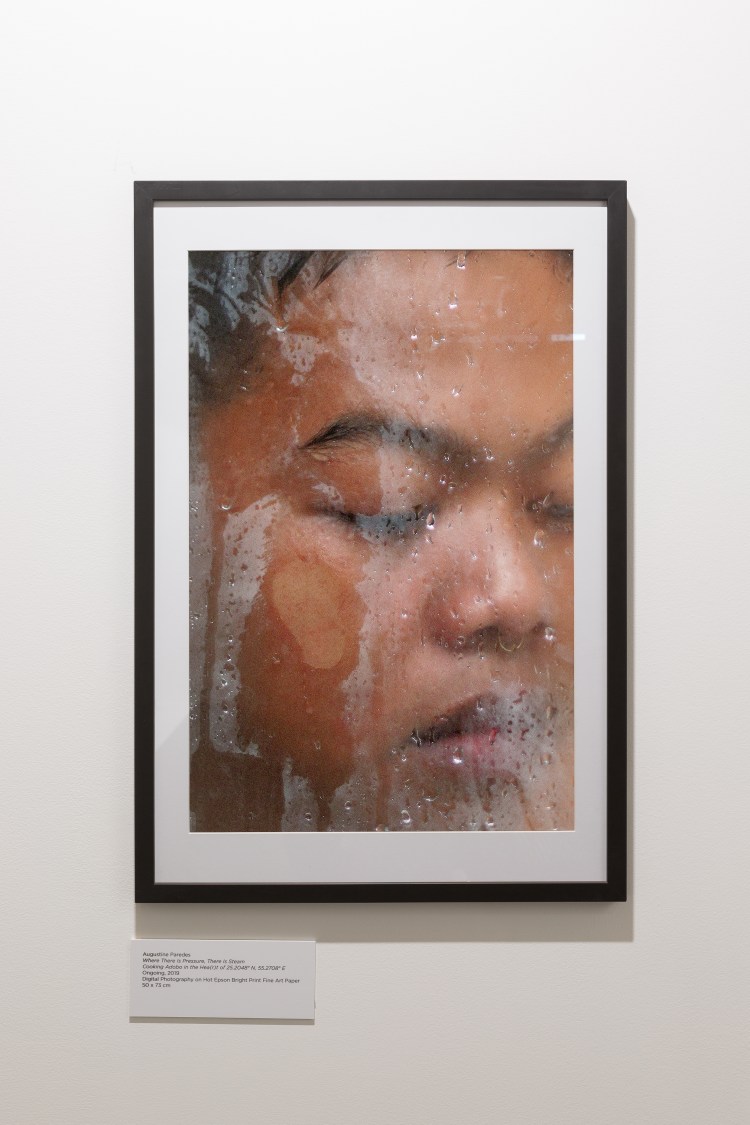Leaving home to be a migrant worker in a different country is like cooking Adobo. Different ingredients in one pot, boiled and simmered – simultaneously stirred in different directions and ways, peppered with additional spices – until finally cooked through and ready to be served – Augustine Paredes
At this year’s Art Dubai photography based artist Augustine Paredes (b. 1994) presented a selection of conceptual and existential self-portraits that commented on his relationship to the city, having lived away from his native Philippines for two years. The body of work titled Cooking Adobo in the Hea(r)t of 25.2048° N, 55.2709° E, comments on life as an overseas foreign worker in Dubai, living in shared spaces, preserving the sense of home, cooking for one and surviving the every day.

The central image on display was Where There is Pressure There is Steam, a self-portrait of Paredes in the shower. A close-up portrait, his eyes are closed, and his face covered in water. When he first moved to Dubai, Paredes rented a top-bunk in a small room with four people. He explained to me that when living in these shared spaces, the only sense of privacy is in the bathroom, a place where no one is watching you, judging you or putting you in a box. In the accompanying catalogue another set of images How to Slouch When Sleeping illustrates Paredes’s initial reaction towards living in such cramped spaces. In the photographs he is in bed, slouching, with his back to the camera. He explains: “As Filipinos we have a saying: If the means are short, learn to slouch and make it work.”

Paredes’s images predominantly consist of food, and the ingredients used to create adobo, a popular Filipino dish that involves meat marinated in vinegar, soy sauce, garlic and black peppercorns. The unofficial national dish of the Philippines, the word “adobo” comes from the Spanish word for “marinade”. The ingredients are photographed in their packaging, and in shopping bags, fresh from the supermarket, pristine, as if sacred and treasured objects.

Heat, blood, sweat and tears – no degree needed – in a large skillet over medium-high heat. Cook pieces until golden brown on all sides. Remove. Stir in the spices; cook until it softens and browns, about 3 years. – The Recipe, Augustine Paredes
The most powerful image though, is not of food, or even Paredes himself, but a scrap of paper. The Recipe is handwritten on a page roughly torn from a notebook. Within the cooking method, edible ingredients are replaced with “blood”, “sweat” and “tears.” The time needed to complete the dish is “about 3 years”, the length of time Paredes has been living in Dubai. And, it is said, that the longer the adobo sits, the more delicious it becomes.

Pour in the rain, and season with a sand storm, fever and colds. Increase the salary and bring to a boil. Reduce heat to medium-low, cover, and simmer until it tenders and cooked through – The Recipe, Augustine Paredes
Within the accompanying catalogue, there are also a selection of images titled I Cut You in Halves. The photographs have literally been sliced into smaller pieces, as though dicing a cut of meat. Yet it is not just the ingredients that have been chopped, but also Paredes’s own body. The overall body of work was partly made in reference to the loaded question “Where are you from?”, and the violence that comes with it. And, in I Cut You in Halves, Paredes has literally put himself in a box.
The images on display were developed under Art Dubai’s Campus Art Dubai programme, an intensive six-month seminar and residency programme providing UAE-based artists with the opportunity to develop their practice under the mentorship of world-renowned tutors, leading to the showcase of their work during Dubai Art Week. Paredes’s resulting Cooking Adobo in the Hea(r)t of Dubai called into question the ways in which we carve out an identity – and find a sense of belonging – in a place that is not our own.
Art Dubai took place at Madinat Jumeirah, Dubai between 20th and 23rd March 2019
